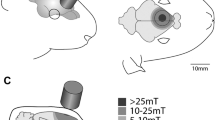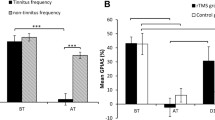Abstract
Repetitive transcranial magnetic stimulation (rTMS) is one form of non-invasive brain stimulation and increasingly shows neuroprotection in multiple neurological disorders. However, the potential of rTMS for protective action on auditory function following acoustic trauma has not been investigated. Here, we examined effect of TMS on hearing conservation, neurons survival and brain-derived neurotrophin factor (BDNF) expression in the cochlea and auditory cortex following acoustic trauma in rats. Wistar rats were exposed to intense pure tone noise (10 kHz, 120 dB SPL for 2 h) followed by rTMS treatment or sham treatment (handling control) daily for 14 days. Auditory brainstem response revealed there was no significant difference in hearing threshold shifts between rTMS- and sham-treated rats, although rTMS-treated rats showed less neuron loss in the auditory cortex in comparison with sham rats. Additionally, acoustic trauma increased BDNF expression in the cochlea and auditory cortex, and this elevation could be attenuated by rTMS treatment. Our results suggest present regiment of rTMS does not protect hearing against acoustic trauma, but maybe have implications for tinnitus treatment.




Similar content being viewed by others
References
Cunningham LL, Tucci DL (2015) Restoring synaptic connections in the inner ear after noise damage. N Engl J Med 372:181–182
Yoon KJ, Lee YT, Han TR (2011) Mechanism of functional recovery after repetitive transcranial magnetic stimulation (rTMS) in the subacute cerebral ischemic rat model: neural plasticity or anti-apoptosis? Exp Brain Res 214:549–556
Kleinjung T, Eichhammer P, Langguth B, Jacob P, Marienhagen J et al (2005) Long-term effects of repetitive transcranial magnetic stimulation (rTMS) in patients with chronic tinnitus. Otolaryngol Head Neck Surg 132:566–569
Bortolomasi M, Minelli A, Fuggetta G, Perini M, Comencini S et al (2007) Long-lasting effects of high frequency repetitive transcranial magnetic stimulation in major depressed patients. Psychiatry Res 150:181–186
Lefaucheur JP, Andre-Obadia N, Antal A, Ayache SS, Baeken C et al (2014) Evidence-based guidelines on the therapeutic use of repetitive transcranial magnetic stimulation (rTMS). Clin Neurophysiol 125:2150–2206
Tang AD, Makowiecki K, Bartlett C, Rodger J (2015) Low intensity repetitive transcranial magnetic stimulation does not induce cell survival or regeneration in a mouse optic nerve crush model. PLoS One 10:e0126949
Makowiecki K, Harvey AR, Sherrard RM, Rodger J (2014) Low-intensity repetitive transcranial magnetic stimulation improves abnormal visual cortical circuit topography and upregulates BDNF in mice. J Neurosci 34:10780–10792
Xiong H, Pang J, Yang H, Dai M, Liu Y et al (2015) Activation of miR-34a/SIRT1/p53 signaling contributes to cochlear hair cell apoptosis: implications for age-related hearing loss. Neurobiol Aging 36:1692–1701
Xiong H, Dai M, Ou Y, Pang J, Yang H et al (2014) SIRT1 expression in the cochlea and auditory cortex of a mouse model of age-related hearing loss. Exp Gerontol 51:8–14
Basta D, Tzschentke B, Ernst A (2005) Noise-induced cell death in the mouse medial geniculate body and primary auditory cortex. Neurosci Lett 381:199–204
Op de Beeck K, Schacht J, Van Camp G (2011) Apoptosis in acquired and genetic hearing impairment: the programmed death of the hair cell. Hear Res 281:18–27
Coordes A, Groschel M, Ernst A, Basta D (2012) Apoptotic cascades in the central auditory pathway after noise exposure. J Neurotrauma 29:1249–1254
Dallos P, Harris D (1978) Properties of auditory nerve responses in absence of outer hair cells. J Neurophysiol 41:365–383
Moore BC, Vinay SN (2009) Enhanced discrimination of low-frequency sounds for subjects with high-frequency dead regions. Brain 132:524–536
Rodger J, Mo C, Wilks T, Dunlop SA, Sherrard RM (2012) Transcranial pulsed magnetic field stimulation facilitates reorganization of abnormal neural circuits and corrects behavioral deficits without disrupting normal connectivity. FASEB J 26:1593–1606
Zuccotti A, Kuhn S, Johnson SL, Franz C, Singer W et al (2012) Lack of brain-derived neurotrophic factor hampers inner hair cell synapse physiology, but protects against noise-induced hearing loss. J Neurosci 32:8545–8553
Auerbach BD, Rodrigues PV, Salvi RJ (2014) Central gain control in tinnitus and hyperacusis. Front Neurol 5:206
Singer W, Panford-Walsh R, Knipper M (2014) The function of BDNF in the adult auditory system. Neuropharmacology 76 Pt C:719–728
Yang S, Weiner BD, Zhang LS, Cho SJ, Bao S (2011) Homeostatic plasticity drives tinnitus perception in an animal model. Proc Natl Acad Sci USA 108:14974–14979
Middleton JW, Kiritani T, Pedersen C, Turner JG, Shepherd GM et al (2011) Mice with behavioral evidence of tinnitus exhibit dorsal cochlear nucleus hyperactivity because of decreased GABAergic inhibition. Proc Natl Acad Sci USA 108:7601–7606
Eggermont JJ, Roberts LE (2004) The neuroscience of tinnitus. Trends Neurosci 27:676–682
Baguley D, McFerran D, Hall D (2013) Tinnitus. Lancet 382:1600–1607
Langguth B, Kreuzer PM, Kleinjung T, De Ridder D (2013) Tinnitus: causes and clinical management. Lancet Neurol 12:920–930
Tan J, Ruttiger L, Panford-Walsh R, Singer W, Schulze H et al (2007) Tinnitus behavior and hearing function correlate with the reciprocal expression patterns of BDNF and Arg3.1/arc in auditory neurons following acoustic trauma. Neuroscience 145:715–726
Panford-Walsh R, Singer W, Ruttiger L, Hadjab S, Tan J et al (2008) Midazolam reverses salicylate-induced changes in brain-derived neurotrophic factor and arg3.1 expression: implications for tinnitus perception and auditory plasticity. Mol Pharmacol 74:595–604
Bing D, Lee SC, Campanelli D, Xiong H, Matsumoto M et al (2015) Cochlear NMDA receptors as a therapeutic target of noise-induced tinnitus. Cell Physiol Biochem 35:1905–1923
Singer W, Zuccotti A, Jaumann M, Lee SC, Panford-Walsh R et al (2013) Noise-induced inner hair cell ribbon loss disturbs central arc mobilization: a novel molecular paradigm for understanding tinnitus. Mol Neurobiol 47:261–279
De Ridder D, De Mulder G, Walsh V, Muggleton N, Sunaert S et al (2004) Magnetic and electrical stimulation of the auditory cortex for intractable tinnitus. Case report. J Neurosurg 100:560–564
Eggermont JJ (2007) Pathophysiology of tinnitus. Prog Brain Res 166:19–35
De Ridder D, Elgoyhen AB, Romo R, Langguth B (2011) Phantom percepts: tinnitus and pain as persisting aversive memory networks. Proc Natl Acad Sci U S A 108:8075–8080
Meng Z, Liu S, Zheng Y, Phillips JS (2011) Repetitive transcranial magnetic stimulation for tinnitus. Cochrane Database Syst Rev 10:CD007946
Peng Z, Chen XQ, Gong SS (2012) Effectiveness of repetitive transcranial magnetic stimulation for chronic tinnitus: a systematic review. Otolaryngol Head Neck Surg 147:817–825
Acknowledgments
This work was supported by the National Natural Science Foundation of China (81200743 and 81570916), Guangdong Natural Science Foundation (2015A030313041) and the Fundamental Research Funds for the Central Universities (13ykpy28).
Author information
Authors and Affiliations
Corresponding author
Ethics declarations
Conflict of interest
The authors have no conflict of interests.
Additional information
H. Yang and H. Xiong contributed equally to this work.
Rights and permissions
About this article
Cite this article
Yang, H., Xiong, H., Ou, Y. et al. Effect of repetitive transcranial magnetic stimulation on auditory function following acoustic trauma. Neurol Sci 37, 1511–1516 (2016). https://doi.org/10.1007/s10072-016-2603-0
Received:
Accepted:
Published:
Issue Date:
DOI: https://doi.org/10.1007/s10072-016-2603-0




